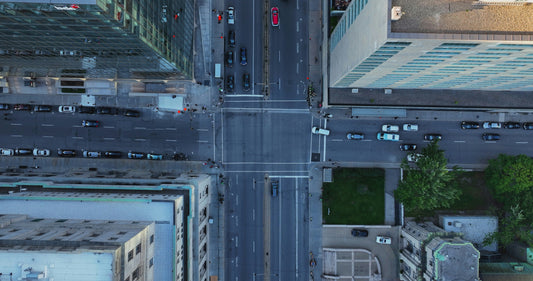In a citywide emergency, it’s crucial to have a plan of action to ensure your safety and that of your family. Cities are densely populated, which often means panic can spread quickly - causing people to act irrationally, or even dangerously. A well-thought-out plan not only increases your chances of staying safe but also helps keep you calm when things get chaotic.
In this article, we’ll outline the top 10 most common urban survival scenarios, and provide you with the essential knowledge to prepare yourself.
Top 10 common urban survival scenarios
1. Natural disasters
Earthquakes, hurricanes, floods, and severe storms can hit urban areas hard. The damage often includes collapsed buildings, road blockages, power outages, utility disruptions, and infrastructure failures. Knowing your region’s natural disaster risks and having emergency kits and evacuation plans can make all the difference.
2. Blackouts and power grid failures
Blackouts can result from various causes including severe weather, high power demand, aging infrastructure, human error, and even cyberattacks. Other less obvious causes include animal interference (like squirrels or birds shorting out transformers), vegetation damage (fallen trees), and sabotage.
When the grid goes down, access to light, heat, water pumps, and communication systems may disappear—so having alternative power sources and lighting, stored water, and charged communication devices is essential.
3. Civil unrest.
Civil unrest can occur suddenly due to political events, protests, economic crises, or other societal stressors. When tensions boil over, cities can quickly become volatile environments. Riots, looting, and confrontations with law enforcement are real possibilities.
In these situations you ought to: avoid large gatherings, stay informed through reliable news sources, and have multiple evacuation routes mapped out. If staying home, reinforce entry points and maintain a low profile to avoid drawing unwanted attention.
4. Economic collapse or hyperinflation
When an economy crashes, the value of money can plummet while the cost of essentials like food, fuel, and medicine skyrockets. In severe cases, shelves may empty and banks may limit access to cash. In an urban setting, this creates high stress and potential conflict.
To prepare, it’s wise to keep a small amount of cash in low denominations and focus on building a modest, sustainable reserve of essentials - enough to avoid frequent trips to stores during peak shortages.
You might also consider learning or gathering practical, tradable skills or goods - like basic repairs, first aid, or extra hygiene items - which can be used in barter if formal currency loses value. The goal isn’t to hoard but to be resilient and community-minded during times of instability.
5. Terrorist attacks/Active shooter situations
These high-stress scenarios often unfold rapidly, especially in crowded public spaces. While rare, they’re serious enough to prepare for. The best tools here are aw areness and calm action: know your exits, trust your instincts, and move away from danger without causing panic. If it’s safe to, help others - especially those who may be vulnerable or confused in the chaos. Consider learning basic emergency response skills or a local community safety training course.
6. Water supply contamination or shortages
Urban water systems are vulnerable to both natural contamination and infrastructure breakdowns. If clean water suddenly becomes scarce, the effects are immediate. Rather than hoarding bottled water, keep a reasonable supply on hand and invest in water filtration or purification tools that can be shared or used long-term. Understanding local water sources, how to treat unsafe water, and staying connected to neighborhood networks can help ensure more people stay safe.
7. Pandemics
Dense city environments accelerate the spread of illness, making pandemics particularly disruptive. Along with health risks, pandemics can strain food systems, limit mobility, and increase social tension. Preparedness here isn’t just about having supplies - it’s also about staying informed, practicing good hygiene, and looking out for your neighbors.
Mutual aid networks and local communication groups proved invaluable during COVID-19 and will be again in the future.
8. Transportation shutdowns
Whether due to fuel shortages, cyberattacks, strikes, or natural disasters, transportation shutdowns can paralyze a city. This affects everything from commuting and deliveries to emergency services. Ensure you have alternate travel plans, like a bicycle or a walking route, and try to keep your vehicle fueled and maintained (if you have one). Also, consider ways to obtain supplies if roads or transit systems shut down.
9. Building fires or collapses
High-rise fires, gas explosions, or structural failures can trap residents and overwhelm emergency services. Know your building’s evacuation routes, practice fire drills with your household, and keep a go-bag near the exit. In addition, owning a smoke hood or small fire extinguisher in your home could save your life.
10. Cyberattacks on infrastructure
Cyberattacks on utilities, financial institutions, or transportation networks can cause massive disruptions. A hacked grid might mean no power, water, or internet - potentially for days. Prepare like you would for a blackout: backup power, stored essentials, and offline copies of key information can make you less dependent on vulnerable systems.
Final Thoughts: Preparedness is a Community Effort
Urban emergencies are unpredictable - but your response doesn’t have to be. Having a plan, understanding the risks, and preparing with intention gives you a serious advantage when things go wrong. But survival doesn’t have to be a solitary pursuit. The most resilient responses come from people who look out for each other, not just themselves.
Preparedness is rooted in care - whether it’s keeping an extra water filter to share, checking in on your neighbors during a power outage, or helping someone navigate a crisis - building stronger, safer communities is important. And in a world where uncertainty is part of the equation, this mindset isn’t just practical: it’s powerful.




